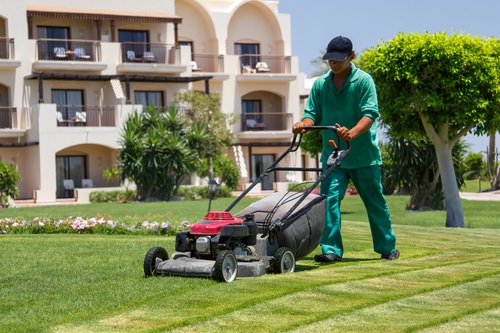
The Complete Manual for Lawn Care Advice

More than just a patch of grass, your lawn serves as an extension of your house, a playground for your kids, and a blank canvas where you can create the garden of your dreams. You must devote time and energy to maintaining a lush, green, and healthy lawn. We'll walk you through some fundamental lawn care techniques in this extensive guide, which will turn your outdoor area into a colorful, desirable haven.
Ability to mow a lawn
The foundation of maintaining a lawn is proper mowing. Observe these rules to ensure a well-kept lawn:
Regularly mow the grass to prevent it from getting too tall. To keep your plant at a constant height, prune frequently.
Employ the proper height: Adapt your lawn mower's height to the type of grass in your area. Warm-season grasses like Bermuda do best at 1 to 1.5 inches, while cool-season grasses like Kentucky bluegrass should be maintained at 2.5 to 3.5 inches.
Sharpen the blades: The grass becomes more prone to disease when the blades are dull. Before the season starts and then on occasion during the season, sharpen the blades on your lawnmower.
Conserve water
Watering your lawn properly is crucial to its health. What you have to do is this:
Water deeply but sparingly: Apply water sparingly. This promotes deeper root growth, strengthening your lawn's resistance to drought.
It's best to water your lawn early in the morning to minimize evaporative water loss.
Steer clear of overwatering: too much water can lead to shallow root growth and fungus diseases. To find out how much water your lawn gets, use a rain gauge.
A basic understanding of conception
For your grass to flourish, it needs the proper nutrients:
Select the appropriate fertilizer: Use a slow-release fertilizer that is balanced and has the right N-P-K ratio for the type of grass you have.
The timing is crucial. To encourage healthy growth, apply fertilizer during the growing season, which is typically spring and fall.
Steer clear of overfertilization because it can lead to overgrowth and deteriorate the quality of the grass.
Weed management
Weeds can quickly take over your lawn if they are not controlled:
Preventive measures: Apply a pre-emergent herbicide early in the spring to eradicate weeds before they sprout.
Spot Treatment: Apply a post-emergence herbicide or pull weeds by hand as soon as they are found.
Weeding and oxygenating
Regularly breathe in fresh air for your lawn.
Aeration: By allowing air, water, and nutrients to reach the roots of your grass, aerating your lawn helps to prevent soil compaction.
Thatch Removal: A layer of dirt and dead grass that can suffocate your lawn is called thatch. As needed to maintain a healthy lawn, weed.
Extermination
Be cautious of pests that could harm your lawn:
- Grubs: A lawn infestation caused by grubs can be disastrous. In late spring or early summer, treat the larvae.
- Insects: Frequently inspect your lawn for indications of insect damage, and treat as needed.
You will be well on your way to having a lovely, healthy lawn that you can enjoy all year long if you heed these lawn care recommendations. Recall that persistence is essential and that short-term effort will eventually pay off. Your haven is here!
Deja una respuesta






Otros artículos que podrían interesarte: